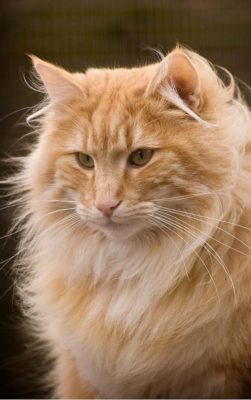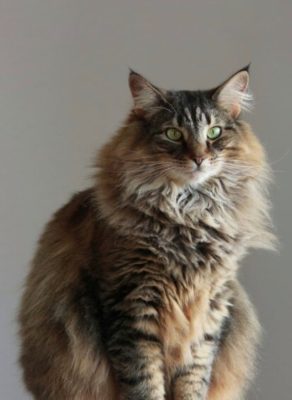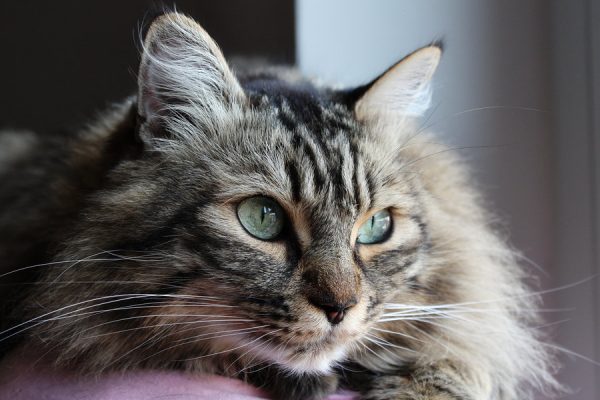Norwegian Forest Cat

This breed has a Nordic character. They are calm, never conflictive, friendly to others, but do not like it when their boundaries are violated. Norwegian Forest cats are used to the wild, so sometimes they have a desire to go outside.
Table of Contents
Breed Information
| Origin | Norway |
| Size | 30-40 cm |
| Weight | 5-10 kg |
| Fur Type | Semi-long-haired |
| Color | Turtle, solid, bicolor, smoky, tabby. A total of 64 color variants are recognized |
| Lifestyle | Outdoors, indoors |
| Lifespan | 14-16 years |
| FIFe Classification | Category II: “Semi-long-haired” Breed designation – NFO |
| WCF Classification | Group 2: “Semi-long-haired” Breed designation – NFO |
| TICA Classification | NF |
| Group | Long-haired cats, popular cats |
| Price | $800-1200 |
Breed Photos
Origin History
The Norwegian Forest cat is considered a mythical symbol of Norway. Its images adorn paintings, and its appearance is mentioned in many legends. King Ulaf V of Norway, in the last century, designated this breed as a national symbol.
Fluffy beauties of Scandinavian forests in the 19th and first half of the 20th centuries existed as pets in Norwegian and Swedish homes.
After the cats surprisingly showed themselves at shows in Germany in the 1930s, breeders began to work seriously to improve this breed’s qualities.
When World War II broke out, cats began to be mass crossbred with other breeds, and the very existence of the Norwegian Forest cat came into question. Thanks to the Norwegian Organization of Pedigree Cat Lovers’ efforts, the breed began to be restored. With Pans Truls and Pippa Skogpuss, the breed received registration with the International Cat Federation, and the pair became the founders of the modern breed. Consequently, the mass export of the breed abroad began. Now Sweden and some European countries have the most pets.
Genetic studies have shown that the Maine Coon is a descendant of the Norwegian Forest cat. Despite their similarity, Norwegian cats have a triangle-shaped muzzle. However, in the U.S., local Maine Coons are still too much competition to Norwegian Forest cats.
Appearance
The cat’s head is shaped as an equilateral triangle. The border between the forehead and the nose of the Norwegian Forest cat is practically absent. Its eyes are quite expressive and large. They are oval in shape, mostly dark in color. White cats are allowed to have different color eyes. This phenomenon is called heterochromia. The nose is of medium length, powerful jaw, and square chin. The ears are of medium size, with slightly rounded tips, and there should be “tassels” on them. The cat has a relatively long, muscular body, strong bones, and a broad chest. The front paws are shorter than the hind legs. The tail is flexible and long.
The coat is long and thick, with an undercoat. The hair along the backbone and on the tail is of maximum length and has water repellent properties. A total of 64 color variations are allowed, which are in harmony with the color of the eyes.
The Norwegian Forest cat is not just larger than other breeds; it weighs more than some dogs. It can weigh up to 5-10 kilograms. Like many large breeds, the cat reaches final maturity at 4-5 years of age.
Character
This breed has a Nordic character. They are calm, never conflictive, friendly to others, but do not like it when their boundaries are violated.
Norwegian Forest cats are used to the wild, so sometimes they have a desire to go outside. In that case, keeping the breed in a private home will be the best option. Sometimes a cat can even go missing for a few days. But this does not mean that she prefers solitude. On the contrary, the long absence of the owner will cause the cat to worry. In general, the Norwegian Forest cat loves all family members and gets along well with other pets.
This breed has a weak voice, so there should be no problem with noise. The high intelligence of these animals is combined with inquisitiveness. The Norwegian Forest cat remembers the habits of the housemates and reacts with surprise to disorder.
Care
Fresh air promotes the healthy shine of a cat’s coat, and physical activity helps support healthy well-being. Therefore, if you live in an apartment, it is recommended to take your cat outside once a month.
The ability to move upright is inherent in the Norwegian Forest cat since childhood. You should buy a special cat tree with a platform on top. Then your pet will feel natural.
Nature has made sure that a cat’s luxurious coat does not bring it many problems. Therefore, there are no problems with the formation of tangles. During the molting period, it is recommended to comb out the animal thoroughly.
Education
If you desire to teach tricks to this breed, it is better to choose not a Norwegian Forest cat. This animal does not like to obey the rules of others. Even a treat in the form of a reward will not interest her at all. But the playfulness of the Norwegian wildcat does not depend on age. It will always support any game, even in old age. These nimble creatures also find entertainment in the street.
Thanks to its strong paws, the Norwegian Forest cat can run upside down through trees.
Common Diseases
The Norwegian Forest cat has good health. Breeding work has had its negative effects, but in general, this animal rarely suffers from serious diseases.
The Norwegian Forest cat is prone to such diseases:
- hip dysplasia;
- glycogen accumulation disease (glycogen type IV), close to diabetes;
- heart disease;
- chronic renal insufficiency – decreased renal function.
Nutrition
There are no special recommendations about feeding the Norwegian Forest cat, but it is worth paying attention to the portion size. Depending on the weight of the cat, the portion should be calculated individually. It is important not to overfeed the cat. Be sure to provide access to freshwater.
 Cornish Rex
Cornish Rex Turkish Van
Turkish Van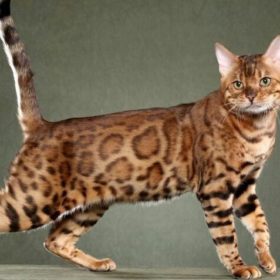 California Spangled
California Spangled Maine Coon
Maine Coon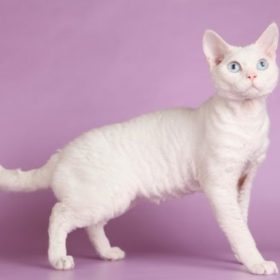 German Rex
German Rex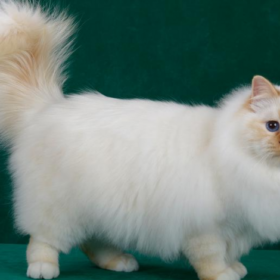 Ragamuffin
Ragamuffin